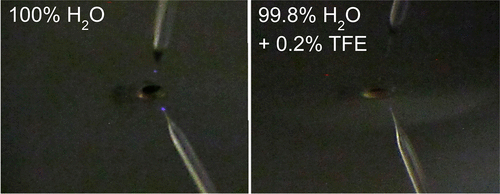当前位置:
X-MOL 学术
›
Anal. Chem.
›
论文详情
Our official English website, www.x-mol.net, welcomes your feedback! (Note: you will need to create a separate account there.)
Corona Discharge Suppression in Negative Ion Mode Nanoelectrospray Ionization via Trifluoroethanol Addition
Analytical Chemistry ( IF 7.4 ) Pub Date : 2017-09-19 00:00:00 , DOI: 10.1021/acs.analchem.7b01225 Phillip J. McClory 1 , Kristina Håkansson 1
Analytical Chemistry ( IF 7.4 ) Pub Date : 2017-09-19 00:00:00 , DOI: 10.1021/acs.analchem.7b01225 Phillip J. McClory 1 , Kristina Håkansson 1
Affiliation

|
Negative ion mode nanoelectrospray ionization (nESI) is often utilized to analyze acidic compounds, from small molecules to proteins, with mass spectrometry (MS). Under high aqueous solvent conditions, corona discharge is commonly observed at emitter tips, resulting in low ion abundances and reduced nESI needle lifetimes. We have successfully reduced corona discharge in negative ion mode by trace addition of trifluoroethanol (TFE) to aqueous samples. The addition of as little as 0.2% TFE increases aqueous spray stability not only in nESI direct infusion, but also in nanoflow liquid chromatography (nLC)/MS experiments. Negative ion mode spray stability with 0.2% TFE is approximately 6× higher than for strictly aqueous samples. Upon addition of 0.2% TFE to the mobile phase of nLC/MS experiments, tryptic peptide identifications increased from 93 to 111 peptides, resulting in an average protein sequence coverage increase of 18%.
中文翻译:

通过三氟乙醇加成在负离子模式纳米电喷雾电离中的电晕放电抑制
负离子模式纳米电喷雾电离(nESI)通常用于通过质谱(MS)分析从小分子到蛋白质的酸性化合物。在高水溶液溶剂条件下,通常会在发射器尖端观察到电晕放电,从而导致离子丰度低和nESI针头寿命缩短。通过将三氟乙醇(TFE)痕量添加到水性样品中,我们已经成功地减少了负离子模式下的电晕放电。添加低至0.2%的TFE不仅在nESI直接输注中,而且在纳流液相色谱(nLC)/ MS实验中均增加了水性喷雾稳定性。具有0.2%TFE的负离子模式喷雾稳定性比严格的水性样品高约6倍。在nLC / MS实验的流动相中添加0.2%TFE后,
更新日期:2017-09-20
中文翻译:

通过三氟乙醇加成在负离子模式纳米电喷雾电离中的电晕放电抑制
负离子模式纳米电喷雾电离(nESI)通常用于通过质谱(MS)分析从小分子到蛋白质的酸性化合物。在高水溶液溶剂条件下,通常会在发射器尖端观察到电晕放电,从而导致离子丰度低和nESI针头寿命缩短。通过将三氟乙醇(TFE)痕量添加到水性样品中,我们已经成功地减少了负离子模式下的电晕放电。添加低至0.2%的TFE不仅在nESI直接输注中,而且在纳流液相色谱(nLC)/ MS实验中均增加了水性喷雾稳定性。具有0.2%TFE的负离子模式喷雾稳定性比严格的水性样品高约6倍。在nLC / MS实验的流动相中添加0.2%TFE后,



























 京公网安备 11010802027423号
京公网安备 11010802027423号